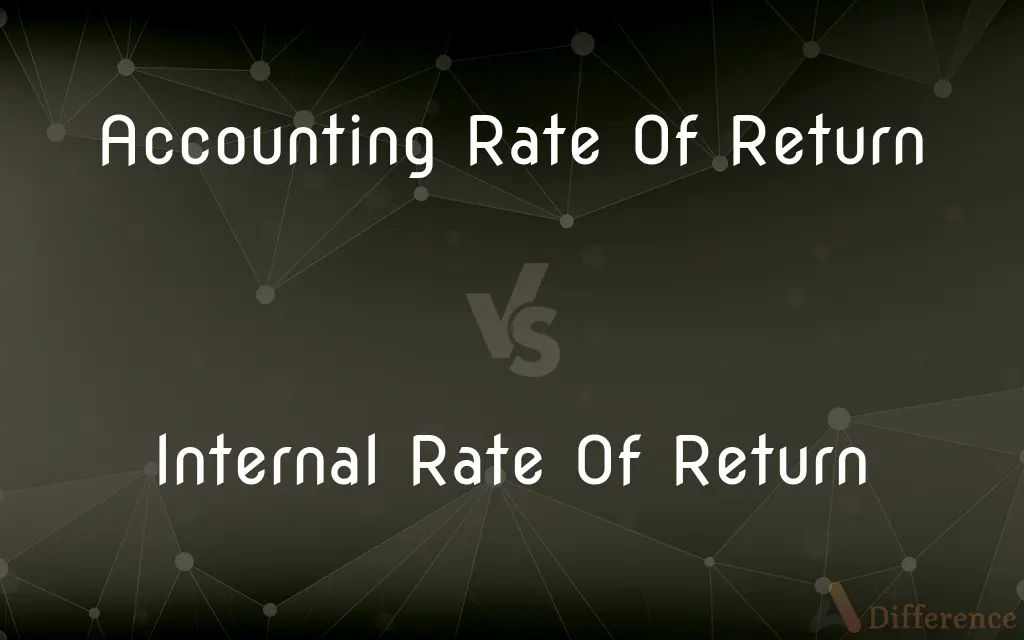Accounting Rate Of Return vs. Internal Rate Of Return — What's the Difference?
By Tayyaba Rehman — Published on October 23, 2023
Accounting Rate of Return (ARR) uses accounting information to measure the profitability of an investment; Internal Rate of Return (IRR) calculates the discount rate at which NPV of an investment equals zero.

Difference Between Accounting Rate Of Return and Internal Rate Of Return
Table of Contents
ADVERTISEMENT
Key Differences
Accounting Rate of Return (ARR) and Internal Rate of Return (IRR) are distinct methods used to evaluate the attractiveness of an investment or project. ARR calculates the return generated from the net income of the proposed investment, focusing on accounting profits to assess project viability. It is simple and easy to understand but does not consider the time value of money. On the other hand, IRR is a discount rate that makes the Net Present Value (NPV) of all cash flows from a particular project equal to zero. It takes into account the time value of money and provides a percentage that signifies the profitability of the project.
ARR is straightforward, utilizing accounting information and emphasizing the average annual accounting profit and initial investment, making it a practical choice for quick assessments of project profitability. However, IRR, by incorporating the time value of money and cash flows, provides a more sophisticated and precise evaluation of an investment’s attractiveness. It reflects the actual gain on investment and is particularly useful for comparing projects with different scales and cash flow profiles, assisting in the optimal allocation of resources.
In the realm of investment appraisal, ARR’s simplicity and reliance on accounting data can be advantageous for initial screenings of investment opportunities. It provides quick insights based on historical data, aiding in swift decision-making processes. Conversely, IRR’s intricate calculations and consideration of cash flows offer more detailed and reliable insights into an investment's potential, enabling comprehensive analysis of investment options and facilitating informed investment decisions.
While ARR can give a general idea of the investment’s profitability, its ignorance of the time value of money and cash flow variability can lead to inaccuracies and skewed results, potentially overlooking viable investments. In contrast, IRR, by addressing these limitations, ensures a thorough and accurate representation of investment profitability, but its complexity may lead to difficulties in interpretation and application, requiring careful consideration and understanding.
Summarily, both Accounting Rate of Return and Internal Rate of Return have their place in investment appraisal, with ARR being suitable for a quick, general overview based on accounting data, and IRR offering a more detailed and accurate evaluation of investment profitability, considering the time value of money and varying cash flows.
ADVERTISEMENT
Comparison Chart
Basis
Accounting information
Cash flows
Consideration
Does not consider the time value of money
Considers the time value of money
Complexity
Simple and easy to calculate
More complex and requires iterative calculation
Application
Quick assessments of project profitability
Detailed analysis and comparison of investment options
Accuracy
May be less accurate due to ignoring cash flows
More accurate due to considering cash flows
Compare with Definitions
Accounting Rate Of Return
Accounting Rate of Return primarily focuses on accounting profits to assess investment attractiveness.
While the Accounting Rate of Return was promising, further analysis was needed to assess cash flows and time value.
Internal Rate Of Return
Internal Rate of Return considers the time value of money and provides a precise evaluation of investment profitability.
Internal Rate of Return revealed the true profitability of the project by considering future cash flows.
Accounting Rate Of Return
Accounting Rate of Return is simple and provides a quick assessment of project viability.
Managers often use Accounting Rate of Return for a swift initial evaluation of project proposals.
Internal Rate Of Return
Internal Rate of Return is the discount rate at which the Net Present Value of an investment equals zero.
The project was considered viable as the Internal Rate of Return exceeded the required rate of return.
Accounting Rate Of Return
Accounting Rate of Return does not consider the time value of money in its calculations.
The lack of time value consideration in Accounting Rate of Return can sometimes lead to skewed results.
Internal Rate Of Return
Internal Rate of Return is complex and requires careful consideration and understanding.
The intricate calculations of Internal Rate of Return demanded a detailed approach to investment appraisal.
Accounting Rate Of Return
Accounting Rate of Return calculates the profitability of an investment based on accounting information.
A high Accounting Rate of Return indicated the investment was profitable based on accounting profits.
Internal Rate Of Return
Internal Rate of Return is effective for comparing projects with different scales and cash flow profiles.
Utilizing Internal Rate of Return allowed for a fair comparison of diverse investment opportunities.
Accounting Rate Of Return
Accounting Rate of Return uses average annual accounting profit and initial investment to measure returns.
The company favored projects with a higher Accounting Rate of Return during the evaluation process.
Internal Rate Of Return
Internal Rate of Return accurately represents investment profitability by considering cash flows and their variability.
Internal Rate of Return provided a comprehensive view of the investment’s potential by accounting for varying cash flows.
Common Curiosities
Is the Accounting Rate of Return easy to calculate?
Yes, Accounting Rate of Return is relatively simple and easy to calculate, providing quick assessments of project profitability.
How is the Internal Rate of Return calculated?
Internal Rate of Return is calculated as the discount rate that makes the Net Present Value of all cash flows from a project equal to zero.
What is the Accounting Rate of Return?
Accounting Rate of Return is a profitability measure that uses accounting information to assess the viability of an investment or project.
Does Accounting Rate of Return consider the time value of money?
No, Accounting Rate of Return does not consider the time value of money, potentially leading to less accurate assessments.
Why is the Internal Rate of Return important?
Internal Rate of Return is important as it considers the time value of money and provides a precise evaluation of investment profitability.
How does Internal Rate of Return impact investment decisions?
Internal Rate of Return provides detailed and reliable insights into investment profitability, aiding in informed and optimal investment decisions.
Can the Internal Rate of Return be used for comparing different projects?
Yes, Internal Rate of Return is effective for comparing projects with different scales and cash flow profiles, facilitating fair comparisons.
Can Accounting Rate of Return overlook viable investments?
Yes, due to its ignorance of the time value of money and cash flow variability, Accounting Rate of Return can potentially overlook viable investments.
What does a high Accounting Rate of Return indicate?
A high Accounting Rate of Return typically indicates that an investment is profitable based on accounting profits.
Does Internal Rate of Return accurately represent investment profitability?
Absolutely, by considering the time value of money and cash flows, Internal Rate of Return ensures an accurate representation of investment profitability.
Is the Internal Rate of Return complex?
Yes, the Internal Rate of Return is more complex and requires careful consideration and understanding for accurate application.
Can Accounting Rate of Return provide quick insights into project viability?
Absolutely, Accounting Rate of Return provides swift and initial insights into project viability based on accounting information.
Share Your Discovery

Previous Comparison
Budding Yeast vs. Fission Yeast
Next Comparison
Surprise vs. TrapAuthor Spotlight
Written by
Tayyaba RehmanTayyaba Rehman is a distinguished writer, currently serving as a primary contributor to askdifference.com. As a researcher in semantics and etymology, Tayyaba's passion for the complexity of languages and their distinctions has found a perfect home on the platform. Tayyaba delves into the intricacies of language, distinguishing between commonly confused words and phrases, thereby providing clarity for readers worldwide.












































